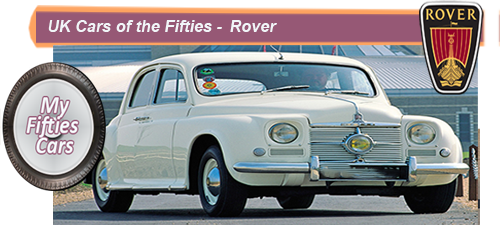
Like so many auto manufacturers that sprang up in England in the late eighteen hundreds, Rover initially set up shop with a plan to manufacture bicycles, with their particular angle being that Rover produced only bicycles with an emphasis on safety.
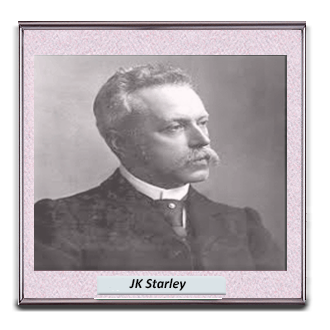 Spurred on by the success of the bicycle manufacturing company, the company's founder JK Starley the driving force behind Rover began building cars in 1904 in a plant in the Midlands city of Coventry.
Spurred on by the success of the bicycle manufacturing company, the company's founder JK Starley the driving force behind Rover began building cars in 1904 in a plant in the Midlands city of Coventry.
From the outset, Starley called his new range of cars Rovers, all of them carrying a Viking long ship logo.
The Rover car company earned themselves a solid reputation filling the growing demand for quality, reliable family saloons for the UK domestic market in the year preceding and following the First World War.
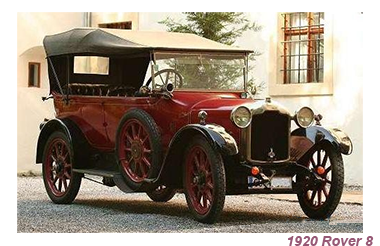 At the same time, as something of an interim step, in 1948 the Rover company launched their basic workhorse known as the Land Rover designed by Spencer Wilks and engineered by his brother,Maurice.
At the same time, as something of an interim step, in 1948 the Rover company launched their basic workhorse known as the Land Rover designed by Spencer Wilks and engineered by his brother,Maurice.
 Known in the car industry for has resilience and design flair, Wilks set aside some of Rover's production facilities to produce an all-terrain vehicle that would play a major part for the UK land forces. as well as a much needed piece of equipment for Britain's farmers .
Known in the car industry for has resilience and design flair, Wilks set aside some of Rover's production facilities to produce an all-terrain vehicle that would play a major part for the UK land forces. as well as a much needed piece of equipment for Britain's farmers .
That utilitarian vehicle went on to become the Land Rover.
![]()
By the mid-thirties, Rover have finished the process of trading, focusing on producing larger and much more luxurious cars.
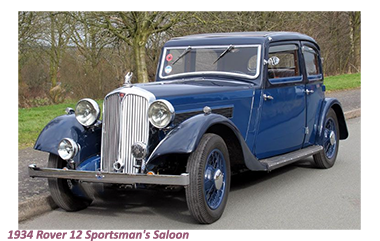 Some of the Rover's best-selling models of that time were the Ten, Twelve, Fourteen, and teen., with the Ten and Twelve being powered by four-cylinder engines of 1,389 and 96 cc while the larger models received their power from 1,901cc six-cylinder units.
Some of the Rover's best-selling models of that time were the Ten, Twelve, Fourteen, and teen., with the Ten and Twelve being powered by four-cylinder engines of 1,389 and 96 cc while the larger models received their power from 1,901cc six-cylinder units.
Remaining independent and growing steadily prosperous throughout the harsh years of the Thirties, by 1939, with the outbreak of World War Two, Rover was well equipped in technical and financial terms to devote their considerable production facilities entirely over to the war effort.
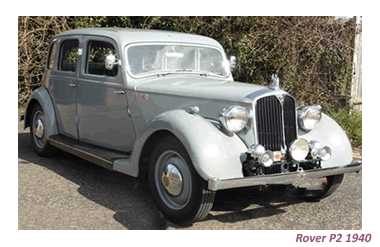 At the height of the bombing raids on England during the early years of the war there Coventry factory destroyed, meaning that post-war operations could only get underway in their new plant based in the industrial town of Solihull, situated to the southeast of Birmingham.
At the height of the bombing raids on England during the early years of the war there Coventry factory destroyed, meaning that post-war operations could only get underway in their new plant based in the industrial town of Solihull, situated to the southeast of Birmingham.
Probably more so than their counterparts in the UK auto manufacturing industry, Rover took time to introduce new post-war models, meaning that cars designed before the outbreak of the Second World War and destruction of the factory were the first they had to offer, marketed as the Rover P2 series.
![]()
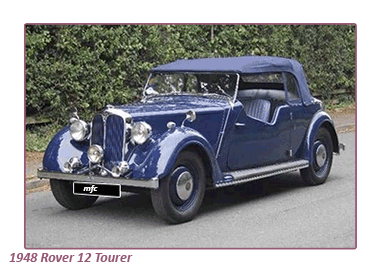
The launch of the Land Rover proved to be an inspired move, with the vehicle going on to become an international best seller, among the best known vehicles in the history of the UK car industry.
Land Rovers are still produced today in some form or other all over the world.
Unfortunately, accurate figures are difficult to source as to how many Land Rovers were manufactured in the close to seventy years that they have been in production.
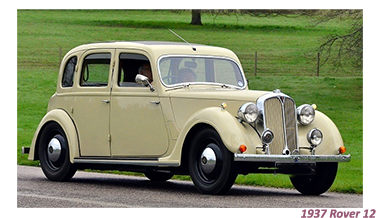 What is a fact that a few years ago the current owners of Land Rover, Tata Motors, proudly claimed that around 75 percent of the vehicles ever sold were still working and travelling on the highways, country lanes and dirt tracks of the world.
What is a fact that a few years ago the current owners of Land Rover, Tata Motors, proudly claimed that around 75 percent of the vehicles ever sold were still working and travelling on the highways, country lanes and dirt tracks of the world.
 The unexpected commercial success of the Land Rover undoubtedly gave the Rover car company time to introduce new brands to take them into the Fifties.
The unexpected commercial success of the Land Rover undoubtedly gave the Rover car company time to introduce new brands to take them into the Fifties.
The first was the P4 series, released in I949, produced in no less than five permutations during the decade, mostly based on engine size and technical details, with the chassis and body in all models being virtually identical.
![]()
The P4 saloon first symbolised the vision of everything Spencer Wilks, the recently appointed managing director at Rover.
Wilks was bareley settled into his new position when World War Two erupted, meaning that all of Rover's production was switced towards the war effort, and the special challenges which it presented.
 At the end of the war Wilks realised that now was the time to produce a new model for the domestic market.
At the end of the war Wilks realised that now was the time to produce a new model for the domestic market.
With the P4s Wilks carried on the well-established Rover theme that performance should be a secondary feature to refinement, high quality, and dignity which he regarded as being of the utmost importance.
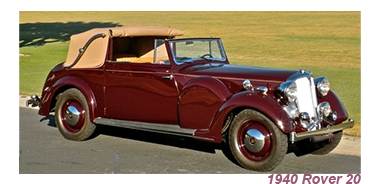 The P4 (which indicated that this was the first phase in a long-term plan of model development) was much like its predecessors, though it looked more modern and incorporated a number of mechanical innovations.
The P4 (which indicated that this was the first phase in a long-term plan of model development) was much like its predecessors, though it looked more modern and incorporated a number of mechanical innovations.
Taking a long-term view, Rover invested heavily in establishing a design and production program for the P4, confident in their ability to produce a car that would sell consistently and over the long term.
With its a pleasingly rounded shape, the P4 series had evidently been built for comfort and not speed.
The only possible criticism that could be heaped on Rover’s design team was the placement of a single headlamp in the middle of the first version the P4 series to be released. Auto commentators rapidly named this version of the Rover P4, the `Cyclops'.
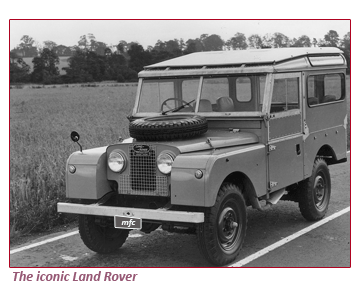 Never a favourite among the UK public, the Cyclops look was done away with as part of the P4’s first facelift. During its fifteen-year run externally the P4 series went through the most minimal of changes, mainly having its rear end squared up a little and its small, oval-shaped rear window resized.
Never a favourite among the UK public, the Cyclops look was done away with as part of the P4’s first facelift. During its fifteen-year run externally the P4 series went through the most minimal of changes, mainly having its rear end squared up a little and its small, oval-shaped rear window resized.
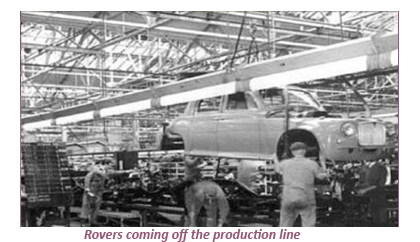 Over the years, the main changes were to the engines and the transmission. Using the model name to indicate peak power output, the original P4s were four-cylinder '60'. 75 and '80' varieties, with more powerful six-cylinder engine versions available and ‘90', '95', '100' and finally '110' (the fastest of these cars could reach 100 mph).
Over the years, the main changes were to the engines and the transmission. Using the model name to indicate peak power output, the original P4s were four-cylinder '60'. 75 and '80' varieties, with more powerful six-cylinder engine versions available and ‘90', '95', '100' and finally '110' (the fastest of these cars could reach 100 mph).
Anyone who thinks of Rover cars in the Fifties will find it difficult to recall any other model than the P4.
Easy to understand when you consider before the P4 was finally displaced by the P6 2000 in 1964, more than 130,000 of these iconic vehicles had been produced.
 Towards the end of the Fifties, Rover launched the larger and more luxurious P5 series that again proved to be a steady seller- well into the Sixties.
Towards the end of the Fifties, Rover launched the larger and more luxurious P5 series that again proved to be a steady seller- well into the Sixties.
The 3-litre engine P5 was designed and produced to compete for sales coming dominated by Jaguar and Daimler and carried the distinction of being Rover's first car to be fitted with a monocoque body.


